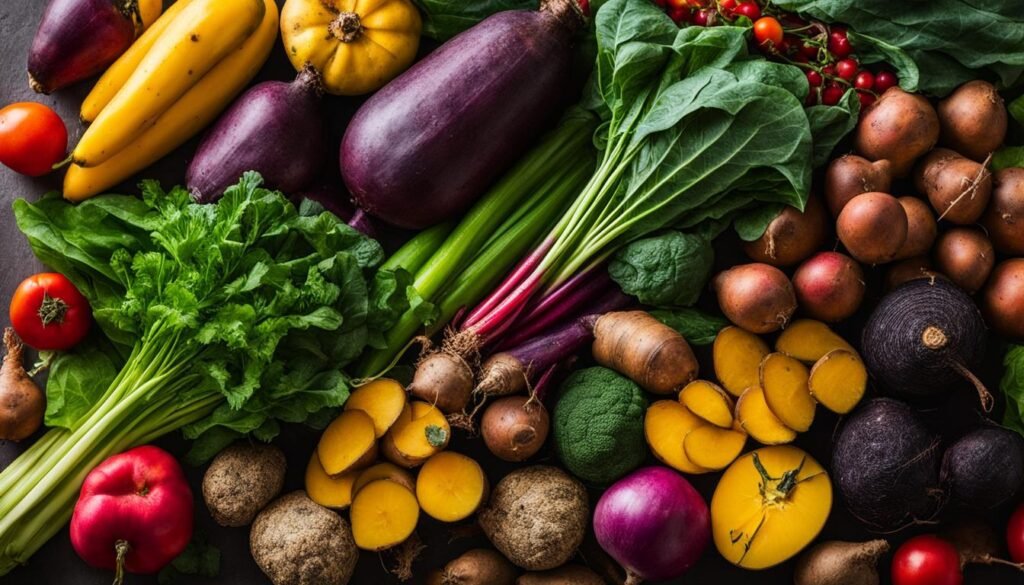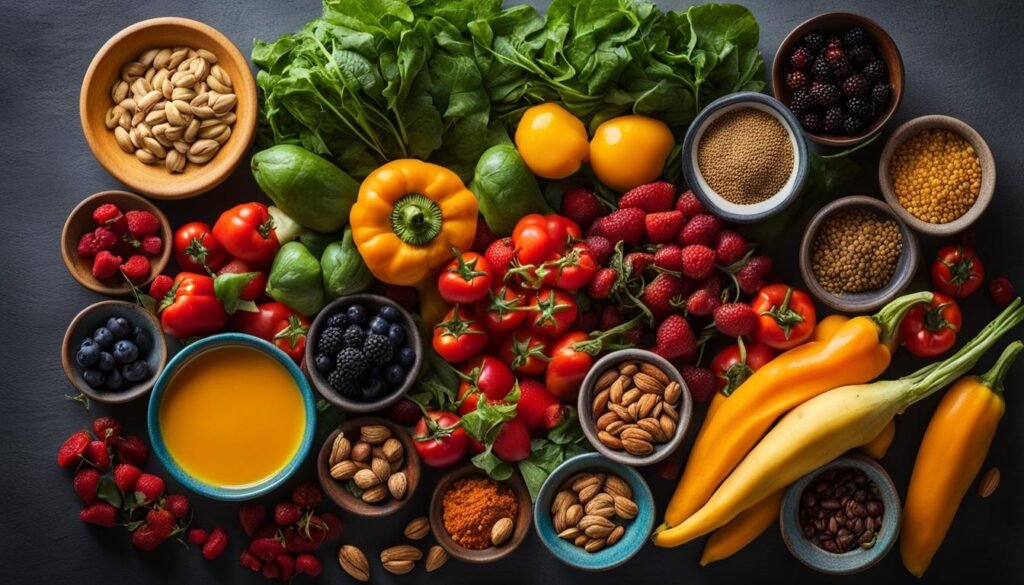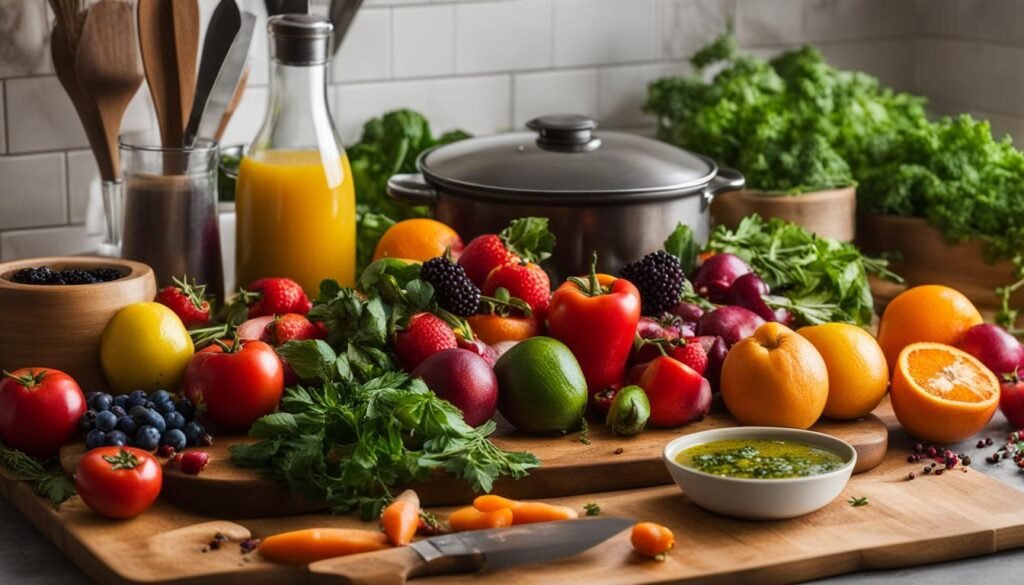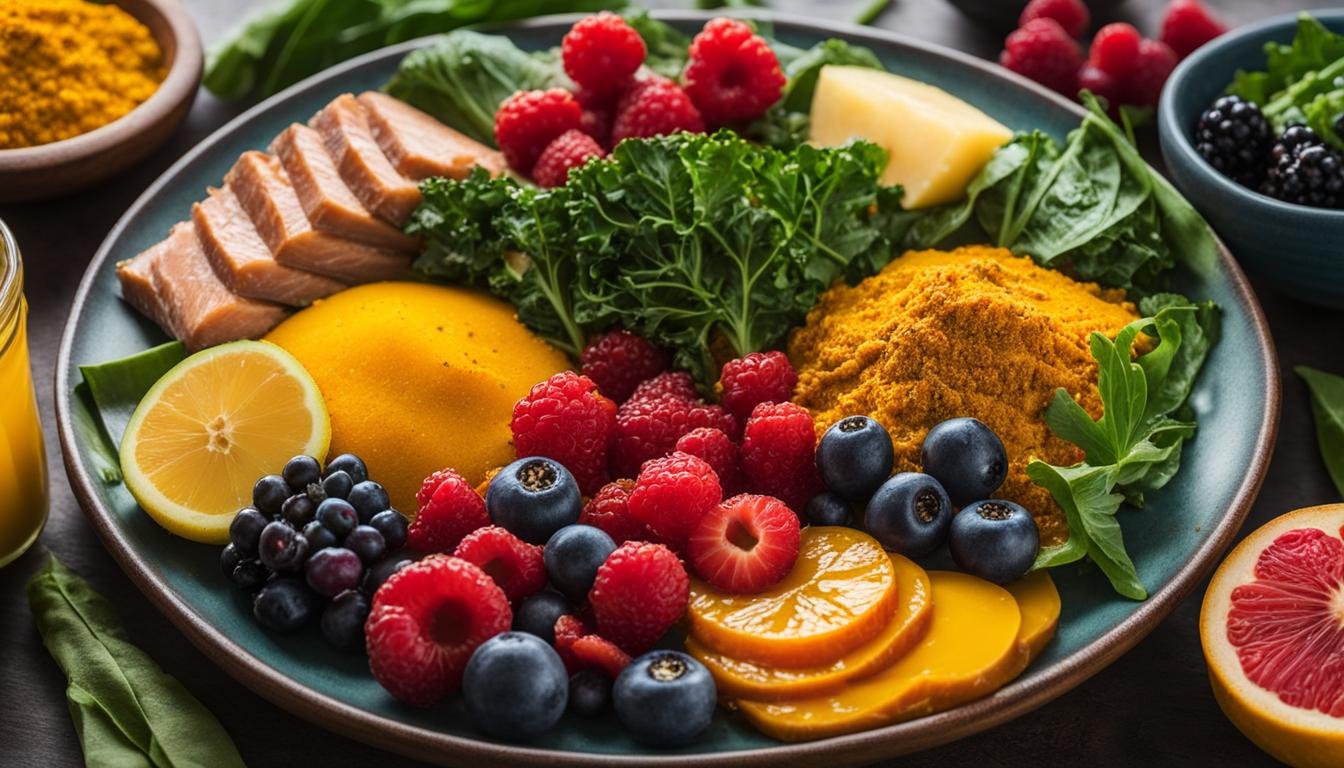Chronic inflammation can be a challenging condition to manage, but did you know that your cooking habits can play a significant role in reducing inflammation and promoting overall health? Experts recommend these 10 cooking tips to help manage chronic inflammation and provide much-needed relief.
- Follow an anti-inflammatory diet: Incorporate foods known for their inflammation-reducing properties.
- Utilize ingredient alternatives: Explore gluten-free options, alternative flours, and healthier sweeteners.
- Include anti-inflammatory spices and herbs: Add flavor and reduce inflammation with spices like turmeric, ginger, and cinnamon.
- Emphasize whole foods: Opt for fresh fruits, vegetables, whole grains, and lean proteins to support overall health.
- Avoid highly processed and greasy foods: Limit consumption of sugary foods, high-fat red meat, and fried dishes.
Takeaways>
By incorporating these tips into your cooking routine, you can create inflammation-reducing recipes that not only taste delicious but also support your overall well-being. Be mindful of individual dietary restrictions and preferences when preparing meals for others, ensuring everyone can enjoy a healthy and satisfying dining experience.
Understanding Chronic Inflammation and Its Impact on Health
Chronic inflammation is a complex biological response that can have a profound impact on overall health. It is a low-grade systemic inflammation that can persist for months or even years, and it is linked to a range of inflammatory diseases and autoimmune disorders. Unlike acute inflammation, which is a normal response to injury or infection, chronic inflammation occurs when there is an imbalance between pro-inflammatory and anti-inflammatory processes in the body.
Chronic inflammation can have wide-ranging effects on the body, including increased levels of oxidative stress, tissue damage, and altered immune responses. It has been associated with an increased risk of heart disease, diabetes, obesity, and certain types of cancer. Additionally, chronic inflammation can lead to symptoms such as fatigue, joint pain, and digestive problems, which can significantly impact an individual’s quality of life.
Recognizing the impact of chronic inflammation is crucial in managing its effects on health. By understanding the underlying causes and implementing dietary interventions, individuals can take proactive steps towards reducing inflammation and improving overall well-being.
The Role of Anti-Inflammatory Ingredients
One of the key factors in managing chronic inflammation is incorporating anti-inflammatory ingredients into the diet. These ingredients, such as fruits, vegetables, whole grains, fatty fish, and herbs, contain bioactive compounds that have been shown to have anti-inflammatory properties. For example, omega-3 fatty acids found in fatty fish like salmon have been found to reduce inflammation in the body.
Additionally, certain spices and herbs, such as turmeric, ginger, and rosemary, are known for their anti-inflammatory effects. These ingredients can be easily incorporated into a variety of dishes, adding both flavor and potential health benefits.
| Anti-Inflammatory Ingredients | Benefits |
|---|---|
| Fatty fish (salmon, mackerel) | Rich in omega-3 fatty acids, which have anti-inflammatory properties. |
| Turmeric | Contains curcumin, a potent anti-inflammatory compound. |
| Ginger | Has gingerol, which has been shown to have anti-inflammatory and antioxidant effects. |
| Rosemary | Contains rosmarinic acid, a natural anti-inflammatory compound. |
“Inflammation is a natural response that helps protect the body from harm. However, when it becomes chronic, it can lead to a range of health issues. By incorporating anti-inflammatory ingredients into your diet, you can help reduce inflammation and support overall health.” – Dr. Jane Johnson, Nutritionist.
By incorporating a variety of anti-inflammatory ingredients into meals, individuals can create delicious and nutritious dishes that not only satisfy their taste buds but also support inflammation management. Experimenting with different flavors and combinations can help individuals find enjoyment in cooking while taking care of their health.
Personalizing the Anti-Inflammatory Diet
When it comes to managing chronic inflammation, it’s important to recognize that each person may have different responses to specific foods. This is why personalizing the anti-inflammatory diet based on individual health needs and tolerances is crucial. By understanding their dietary restrictions, individuals can make informed choices and create meals that support their inflammation management.
One aspect to consider is the inclusion or exclusion of high FODMAP foods. FODMAPs are a group of carbohydrates that can contribute to digestive symptoms in some individuals. For those who find it helpful to limit high FODMAP foods, avoiding items such as onions, garlic, and certain fruits can be beneficial in managing inflammation. Additionally, individuals with gluten intolerance or sensitivity may need to eliminate gluten-containing foods, while others may find it helpful to reduce their intake of sweeteners or excessive sodium.
“Everyone’s body is different, so what works for one person may not work for another. It’s essential to pay attention to how your body responds to specific foods and make adjustments accordingly,” explains Dr. Sarah Thompson, a registered dietitian specializing in inflammation management.
By personalizing the anti-inflammatory diet, individuals can find the food choices that work best for them. This not only helps manage chronic inflammation but also ensures that meals are enjoyable and satisfying. It may be helpful to consult with a healthcare professional or registered dietitian to create a personalized plan that takes into account individual responses and dietary restrictions.
Table: Examples of High FODMAP Foods
| Foods High in FODMAPs | Foods Low in FODMAPs |
|---|---|
| Onions | Carrots |
| Garlic | Bell peppers |
| Apples | Oranges |
Understanding individual responses to specific foods and dietary restrictions is key to successfully managing chronic inflammation through cooking. By personalizing the anti-inflammatory diet, individuals can create meals that not only support their health but also cater to their unique needs and preferences.
Preventing Cross-Contamination in the Kitchen
When it comes to managing chronic inflammation, individuals with conditions like celiac disease or gluten intolerance need to be extra cautious in the kitchen. Cross-contamination can occur easily, potentially causing discomfort and health issues. To ensure the safety of those with dietary restrictions, it is important to follow proper hygiene and food handling practices.
One effective way to prevent cross-contamination is by using a separate cutting board for gluten-free ingredients. This helps to avoid any contact between gluten-containing foods and those that need to be gluten-free. Additionally, it is crucial to wash hands thoroughly and regularly, especially when switching between different types of ingredients.
“Cross-contamination in the kitchen can pose a major problem, especially for individuals with celiac disease or gluten intolerance.”
Another helpful tip is to avoid using shared utensils when preparing meals. Using separate utensils for different ingredients minimizes the risk of cross-contamination. For example, using a clean spoon to scoop out mayonnaise instead of double-dipping with the same knife used for spreading peanut butter.
By being mindful of these precautions, individuals with dietary restrictions can safely enjoy their meals without worrying about cross-contamination. It’s essential to create a kitchen environment that promotes health and caters to everyone’s needs.
Utilizing Ingredient Alternatives and Healthy Cooking Techniques

When it comes to managing chronic inflammation through cooking, incorporating ingredient alternatives and healthy cooking techniques is key. There are now a variety of options available for those avoiding certain ingredients or looking to add more nutrient-rich alternatives to their meals.
For individuals following a gluten-free diet, gluten-free pasta is a great alternative to traditional wheat-based pasta. It offers the same satisfying texture and can be used in a variety of dishes. Additionally, alternative flours such as almond flour or coconut flour can be used in baking recipes to replace refined white flour and add a boost of nutrients.
When it comes to grains, opting for whole-grain products is a healthier choice. These grains retain more of their natural fiber and nutrients compared to processed grains. Incorporating whole grains like quinoa, brown rice, or whole-wheat bread into your meals can help reduce inflammation and provide lasting energy.
Table: Alternative Flours Comparison
| Alternative Flour | Benefits | Recipe Ideas |
|---|---|---|
| Almond Flour | Gluten-free, high in healthy fats and vitamin E | Almond flour pancakes, almond flour cookies |
| Coconut Flour | Gluten-free, high in fiber and healthy fats | Coconut flour muffins, coconut flour bread |
| Buckwheat Flour | Gluten-free, high in fiber and minerals | Buckwheat pancakes, buckwheat bread |
When it comes to sweetening your dishes, opting for less refined sweeteners is a healthier choice. Natural sweeteners like honey, maple syrup, or stevia can be used in place of white sugar. These alternatives provide a touch of sweetness while also offering additional nutrients.
Lastly, incorporating healthy fats into your meals is important for managing inflammation. Avocados, olive oil, and nuts are all excellent sources of healthy fats. These fats help reduce inflammation and support overall heart health.
Incorporating Anti-Inflammatory Spices and Herbs
Spices and herbs not only add flavor to dishes but can also provide valuable anti-inflammatory benefits. Incorporating these natural ingredients into your cooking can be a simple yet effective way to manage chronic inflammation. Here are some key anti-inflammatory spices and herbs to include in your culinary repertoire:
Cinnamon
Cinnamon is a versatile spice that can be used in both sweet and savory dishes. Studies have shown that cinnamon possesses anti-inflammatory and antioxidant properties, which can help reduce inflammation in the body. Sprinkle a little cinnamon on your morning oatmeal or add it to roasted vegetables for a touch of warmth and flavor.
Cloves
Cloves are known for their rich aroma and distinctive flavor. They contain compounds that have been shown to possess anti-inflammatory properties, making them beneficial for managing chronic inflammation. Use cloves to infuse flavor into soups, stews, or marinades for meats.
Ginger
Ginger has long been used in traditional medicine for its anti-inflammatory properties. The active compounds in ginger, such as gingerol, have been found to reduce inflammation and provide relief from pain. Grate fresh ginger into stir-fries, soups, or smoothies for a zesty and anti-inflammatory boost.
Nutmeg
Nutmeg is a warming spice that adds depth of flavor to both sweet and savory dishes. It contains compounds that have anti-inflammatory and antioxidant properties, making it a valuable addition to your pantry. Sprinkle a pinch of nutmeg on your morning latte or use it to elevate the flavor of creamy pasta sauces.
Other anti-inflammatory spices and herbs that you can incorporate into your cooking include cardamom, crushed red pepper, rosemary, turmeric, and lemon juice. These ingredients not only enhance the taste of your dishes but also provide valuable health benefits. Experimenting with different combinations of these spices and herbs can help you create flavorful and inflammation-reducing meals.
Emphasizing Whole Foods and Anti-Inflammatory Ingredients

When it comes to managing chronic inflammation through cooking, one of the key strategies is to focus on incorporating whole foods and anti-inflammatory ingredients into your meals. Whole foods such as fruits, vegetables, whole grains, plant-based proteins, fatty fish, and fresh herbs offer a wealth of nutritional benefits and are known for their anti-inflammatory properties. By including these ingredients in your recipes, you can create delicious and nutritious meals that support inflammation management and overall well-being.
Whole foods are a rich source of antioxidants, vitamins, minerals, and phytochemicals, all of which play a crucial role in reducing inflammation in the body. Fruits and vegetables, in particular, are packed with these essential nutrients and offer a wide variety of flavors and textures to enhance your dishes. Whole grains provide fiber and complex carbohydrates to keep you feeling satisfied and energized, while plant-based proteins like legumes and tofu offer a healthy alternative to animal-based proteins.
Fatty fish, such as salmon and sardines, are rich in omega-3 fatty acids, which have been shown to have anti-inflammatory effects. Incorporating these fish into your meals a few times a week can provide a boost of essential fats and help reduce inflammation. Fresh herbs like rosemary, basil, and cilantro not only add flavor but also offer anti-inflammatory and antioxidant benefits.
| Foods | Benefits |
|---|---|
| Fruits and vegetables | Rich in antioxidants, vitamins, minerals, and phytochemicals. Help reduce inflammation. |
| Whole grains | Provide fiber and complex carbohydrates. Promote satiety and sustained energy levels. |
| Plant-based proteins | Offer a healthy alternative to animal-based proteins. Support inflammation management. |
| Fatty fish | Rich in omega-3 fatty acids. Have anti-inflammatory effects and contribute to overall health. |
| Fresh herbs | Add flavor and provide anti-inflammatory and antioxidant benefits. |
Incorporating whole foods and anti-inflammatory ingredients into your cooking not only helps manage chronic inflammation but also adds a delicious and diverse range of flavors to your meals. Experiment with different recipes, try new fruits and vegetables, and explore various herbs and spices to create nutritious and inflammation-reducing dishes that support your overall health and well-being.
Foods to Avoid for Chronic Inflammation Management
When it comes to managing chronic inflammation, certain foods should be avoided as they can exacerbate inflammation and contribute to health issues. By making conscious choices to limit these inflammatory foods, individuals can take a proactive approach to inflammation management. Here are some key foods to avoid:
| Inflammatory Foods |
|---|
| Highly processed foods |
| Greasy foods |
| Sugary foods |
| High-fat red meat |
| Butter |
| Whole milk |
| Cheese |
| Fried foods |
| Trans fats |
| Gluten |
Highly processed foods are often loaded with additives, preservatives, and unhealthy fats, which can trigger inflammation in the body. Greasy foods, like fried foods, are high in saturated and trans fats that can increase inflammation and contribute to chronic health conditions. Sugary foods, such as sodas, candies, and desserts, can also lead to inflammation, especially when consumed in excess.
It’s important to limit the consumption of high-fat red meat, butter, whole milk, and cheese as they contain saturated fats that can contribute to inflammation. Fried foods, particularly those cooked in unhealthy oils, are known to promote inflammation in the body. Trans fats, found in many processed and packaged foods, are not only linked to increased inflammation but also have detrimental effects on heart health.
For individuals with gluten intolerance or celiac disease, avoiding gluten is crucial. Gluten-containing foods, such as wheat, barley, and rye, can trigger an immune response that leads to inflammation. By eliminating or reducing gluten intake, individuals can better manage their inflammation levels and improve their overall health.
“Inflammation is the body’s way of protecting itself, but chronic inflammation can lead to significant health issues. By avoiding highly processed foods, greasy foods, sugary foods, high-fat red meat, butter, whole milk, cheese, fried foods, trans fats, and gluten, individuals can take a proactive approach to managing chronic inflammation.”
The Link Between Diet and Inflammation-Reducing Recipes

When it comes to managing chronic inflammation, incorporating inflammation-reducing recipes into your diet can make a significant difference. By using ingredients known for their anti-inflammatory properties and focusing on whole foods, you can create meals that are both delicious and supportive of inflammation management.
One example of an inflammation-reducing recipe is whole-wheat penne with Swiss chard and white beans. This dish incorporates whole-grain pasta, which provides fiber and nutrients, Swiss chard, a leafy green packed with antioxidants, and white beans, a plant-based source of protein. The combination of these ingredients not only satisfies your taste buds but also helps quell inflammation in the body.
Another tasty option is roasted salmon with broccoli and tomatoes. Salmon is a fatty fish rich in omega-3 fatty acids, known for their anti-inflammatory properties. Pairing it with broccoli, a cruciferous vegetable packed with antioxidants, and tomatoes, which provide lycopene, creates a flavorful and nourishing meal that supports inflammation reduction.
| Recipe | Ingredients | Benefits |
|---|---|---|
| Whole-Wheat Penne with Swiss Chard and White Beans | Whole-wheat penne, Swiss chard, white beans, garlic, olive oil, red pepper flakes | – High in fiber and antioxidants – Plant-based protein source – Supports digestive health |
| Roasted Salmon with Broccoli and Tomatoes | Salmon fillets, broccoli florets, cherry tomatoes, lemon zest, garlic, olive oil, salt, pepper | – Rich in omega-3 fatty acids – Antioxidant-packed vegetables – Supports heart health |
By incorporating these inflammation-reducing recipes into your cooking repertoire, you can enjoy delicious meals while actively managing chronic inflammation. Remember to experiment with different ingredients and flavors to find combinations that suit your taste preferences and dietary needs. Prioritize whole foods and anti-inflammatory ingredients to support your overall health and well-being.
Tips for Cooking Inflammation-Friendly Meals
When it comes to cooking for individuals managing inflammatory conditions, it’s important to offer a diverse variety of options that cater to their dietary needs. This includes providing gluten-free, dairy-free, and plant-based options to accommodate different restrictions and preferences. By considering these factors, you can ensure that all guests can enjoy the meal without any discomfort or compromise to their health.
Clear labeling of dishes with their ingredients is also crucial in helping guests easily identify suitable options. This promotes transparency and allows individuals to make informed choices based on their specific dietary needs. Whether it’s indicating gluten-free, dairy-free, or plant-based options, clear labeling provides reassurance and peace of mind to those managing chronic inflammation.
Furthermore, incorporating anti-inflammatory ingredients into your recipes can enhance the nutritional value of your meals. This can include using whole foods, fresh herbs, and spices that are known for their anti-inflammatory properties. By utilizing these ingredients, you not only create flavorful dishes but also provide additional health benefits to individuals managing chronic inflammation.
In summary, when cooking inflammation-friendly meals, it’s important to offer a diverse variety of options, including gluten-free, dairy-free, and plant-based choices. Clear labeling of dishes and incorporating anti-inflammatory ingredients can enhance the dining experience for individuals managing chronic inflammation and support their overall well-being.
Conclusion
Incorporating these cooking tips into your routine can greatly contribute to managing chronic inflammation. By following an anti-inflammatory diet, focusing on whole foods, and utilizing healthy cooking techniques, you can create delicious and inflammation-reducing meals.
Remember to consider individual dietary restrictions and preferences when cooking for others. Prioritizing health through cooking can lead to improved well-being and increased enjoyment of meals.
So, start implementing these cooking tips today and take control of chronic inflammation management. Embrace the benefits of an anti-inflammatory diet, explore healthy cooking methods, and discover inflammation-reducing recipes that will nourish your body and delight your taste buds.
FAQ
What health conditions are linked to chronic inflammation?
Chronic inflammation is linked to various health conditions, including cardiovascular disease, arthritis, and diabetes.
How can chronic inflammation be managed through cooking?
Experts recommend following an anti-inflammatory diet, focusing on whole foods, utilizing healthy cooking techniques, and incorporating inflammation-reducing recipes.
Is the anti-inflammatory diet personalized for each individual?
Yes, each person’s response to specific foods can vary, so it’s important to personalize the anti-inflammatory diet based on individual health needs and tolerances.
What precautions should be taken to prevent cross-contamination in the kitchen?
To prevent cross-contamination, it is essential to wash hands, avoid using shared utensils, and use separate cutting boards, especially for individuals with celiac disease or gluten intolerance.
Are there ingredient alternatives available for individuals with dietary restrictions?
Yes, there are various ingredient alternatives available, such as gluten-free pasta, alternative flours, and less refined sweeteners. Whole-grain products and healthy fats can also be incorporated into recipes.
Which spices and herbs have anti-inflammatory properties?
Many spices and herbs have anti-inflammatory properties, including cinnamon, cloves, ginger, nutmeg, cardamom, crushed red pepper, rosemary, turmeric, and cooking with lemon juice can also provide inflammation-quelling benefits.
What foods should be emphasized in an anti-inflammatory diet?
An anti-inflammatory diet should emphasize whole foods, including fruits, vegetables, whole grains, plant-based proteins, and fatty fish. Fresh herbs and spices can also be added for additional antioxidants.
Which foods should be avoided to manage chronic inflammation?
It is important to avoid highly processed, greasy, and sugary foods. High-fat red meat, butter, whole milk, cheese, fried foods, trans fats, and gluten-containing foods should also be limited or avoided.
Can cooking inflammation-reducing recipes help manage chronic inflammation?
Yes, incorporating inflammation-reducing recipes into the diet can have a positive impact on chronic inflammation. Recipes such as black bean bowls, pasta with Swiss chard and white beans, and roasted salmon with broccoli and tomatoes utilize ingredients known for their anti-inflammatory properties.
How can cooking for individuals with inflammatory conditions be approached?
When cooking for individuals managing inflammatory conditions, it is important to offer a diverse variety of options, including gluten-free, dairy-free, and plant-based options. Clear labeling of dishes with their ingredients helps guests with dietary restrictions easily identify suitable options.
How can chronic inflammation be managed through cooking?
By following an anti-inflammatory diet, focusing on whole foods, utilizing healthy cooking techniques, and considering individual dietary restrictions and preferences, you can create delicious and inflammation-reducing meals that promote health and well-being.
